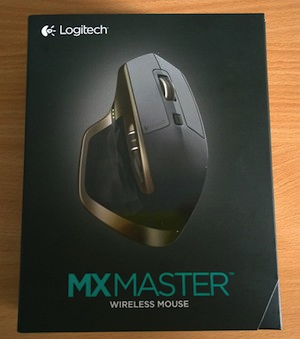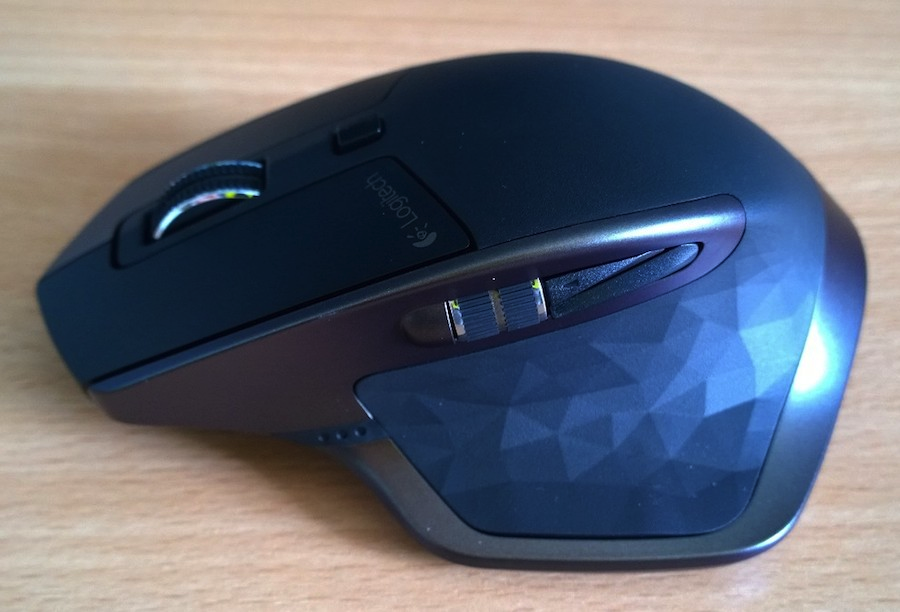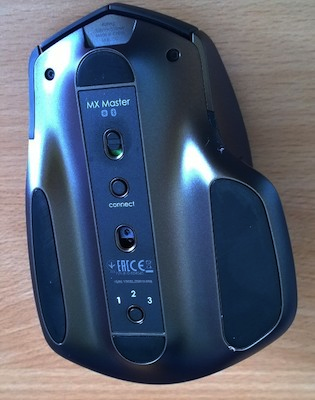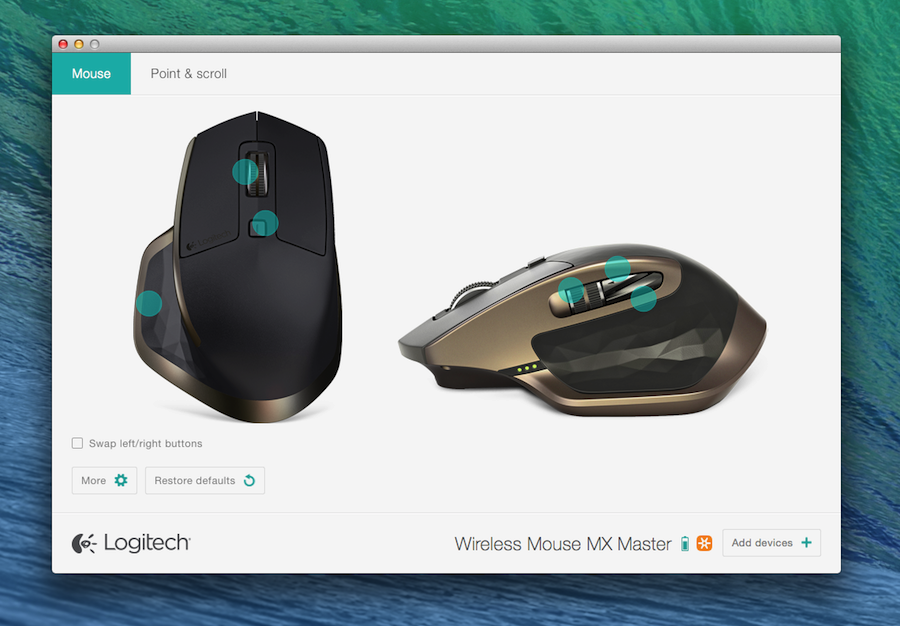Reviewing the Logitech MX Master
posted on
The mouse in the photo below has been my trusty companion for the best part of 9 years now. It, paired with the Microsoft Natural Ergonomic 4000, have been my main input devices throughout most of my programming career. It features 5 buttons, a rocker on the side (which could work as 3 more buttons) and a high speed scroll wheel, all of which can be re-configured to do a multitude of tasks using Logitech's driver software. It is the Logitech MX Revolution and it is by far the best mouse ever produced.

Last year I replaced my Natural Ergonomic 4000 with it's successor, the Microsoft Sculpt. It showed that, even when I consider something the best, it can still be improved upon. Sadly Logitech's follow up to the Revolution, the MX Performance (released in 2009), didn't really do that. It was a good mouse, featuring several improvements, but it also featured many changes that took away from the Revolution (in particular the loss of the rocker control, which reduce its available buttons).
Unfortunately my Revolution has started showing its age. It still works reasonably well, but it has started to lag somewhat and the battery life isn't what it used to be. This presented me with a choice of searching for new MX Revolution (a costly and difficult preposition) or buying what I considered to be an inferior mouse. Thankfully, Logitech stepped in at the last minute to announce a new flagship mouse: the MX Master.

The New Pretender
I actually discovered the MX Master's existence when I saw an article saying Logitech was getting out of the mouse business. Such a statement induces a panic in me only equalled by the statements "Microsoft is getting out of the keyboard business" and "Apple is getting out of the computer business". Thankfully it was misreported, and Logitech was merely getting out of the low margin OEM business, but it did prompt me to visit their website and discover the Master had recently been released.
The first thing you notice when it arrives is how nice the box is. It's not quite Apple levels of design, but it's nice nonetheless. The cover opens up to reveal the mouse inside and is held in place by a magnet when closed, so if you're like me you messed around with it for a while, because magnets.
The box contains the mouse itself, along with one of Logitech's unifying adapters, a USB cable and various bits of documentation.
Design
At first glance the Master seemed a lot more bulky than the Revolution, though when placed side by side there isn't that much difference. The Master is a lot more angular compared to the flowing curves of the Revolution and Performance mice. It's also somewhat flatter, allowing your hand to sit further back and not grasp the mouse so tight, which feels a lot more comfortable in the hand.
One big problem with the Revolution was it getting mucky. There were seams between parts right under your palm and the thumb rest had a pitted rubber texture. It collected dirt and grease from your hands quite easily and so required quite a bit of cleaning. The Master has no real joins that your hands pass over, besides the top of the left and right buttons. The one join on the side fits nicely between your thumb and index finger so is never under your hand. The pitted thumb rest is also replaced with an angular design, that both looks and feels quite nice.

Buttons and Gestures
Some people may question the need for many buttons on a mouse, but once one has used such a mouse it's hard to go back. From my Revolution I could not only control the cursor and click, but I could copy and paste, and switch between desktops. It helps reduce a lot of context switching between keyboard and mouse, and ultimately makes you far more productive.
The Master has 5 obvious buttons: left & right click, a small middle button, and back/forward buttons on the side. As in many mice the scroll wheel can also click, usually acting as a middle click. Finally the thumb rest is itself a button, albeit a somewhat hidden one.
The Master also supports a series of gestures. By holding down a button (by default the thumb rest button) while moving the mouse up, down, left or right, you can invoke these gestures. Like pretty much everything on the mouse, these can be fully customised to peform a plethora of tasks (see Software below).
Scroll Wheels
One of the best features of any of Logitech's high end mice is the high speed scroll wheel, introduced with the Revolution. It works like a regular scroll wheel, moving in increments for fine scrolling. However, it can also switch to a free spin mode which scrolls continuously, allowing for incredibly fast and easy scrolling through long lists or documents. You can choose to switch modes manually using a button press, but it really comes into its own when you use SmartShift, which will automatically switch to the free spin mode when you start scrolling quickly.
The Master also introduces a second scroll wheel. The Revolution, like many mice, had a scroll wheel that rocked from side to side to allow horizontal scrolling. It worked, but it was clunky and inaccurate. Usually it was faster just to hold down shift while scrolling. The Master's second scroll wheel fixes this by allowing you to scroll horizontally with your thumb. Of course this can be even more useful if switched to other functions.

Connecting
The Revolution and Performance connected to your computer using a wireless receiver that you plugged into a USB port. This has advantages in terms of latency and speed of setup, but meant you lost a USB port (not a big problem if you're on an iMac like me, but awkward on a laptop, especially as the Revolution's receiver is around 1.5-2" long).
The Master is Logitech's first flagship mouse to support both a wireless receiver and Bluetooth. Not only that, it can also be paired with up to 3 different computers. Connecting is easy. On the bottom of the mouse is a button that lets you select a device (numbered 1, 2 or 3). Pressing the connect button puts it into pairing mode. You can then plug in a wireless receiver or pair via bluetooth. Once paired, switching between computers is as easy as pressing the device button again.
Unfortunately the bluetooth connectivity only works with Mac OS X 10.10 and Windows 8. If you are using a previous version of the OS you'll need to stick with a wireless receiver.
Battery Life and Charging
The Master boasts up to 40 days usage on a single charge. I've yet to need to charge it since it arrived last week, so I can't really back that up. One potential problem I've seen others mention is that the battery is built in, though the same is true of the Revolution and after nearly 9 years of use it can still hold around enough charge for a week's worth of work.
The biggest problem with the Revolution was that it came with a charging dock, which meant that it could not be used while charging. Like the Performance before it, the Master foregoes this dock in favour of a USB port, allowing you to plug in and charge while still using the mouse (effectively in a corded manner). Logitech claims that you can get enough charge for a full day's use from just 4 minutes charging, though in most cases you might as well just leave it plugged in until fully charged.
Software
The Master uses the relatively new Logitech Options software to customise it. Unlike the previous Logitech Control Center, this lives in the Applications folder so you can open it without needing to go through System Preferences.
You can configure the usual suspects of pointer speed, scroll speed, scroll directions, etc. It also allows full customisation of all the buttons, bar the left and right mouse buttons, allowing you to tie them to the actions listed below. The various gestures can also be connected to most of the same actions.
- App Exposé
- Back
- Forward
- Gesture button
- Keystroke assignment
- Launchpad
- Look up
- Middle button
- Mission Control
- Mode shift button (not available on side buttons)
- Mouse sensitivity
- Screen capture
- Show desktop
- Smart zoom
- Zoom using scroll wheel
The horizontal scroll wheel has a different set of actions that can be assigned to it:
- Switch between pages
- Brightness control
- Horizontal scrolling
- Navigate between apps
- Navigated between tabs
- Show/hide notifications
- Switch between desktops
- Volume control
- Zoom
One flaw (possibly the only major regression from the Revolution) is that the software does not allow you to configure settings per-app. I had my Revolution set up to allow me to switch between tools in Photoshop or select unit groups in Starcraft. While I can still do this, I do so at the sacrifice of other uses.

My Setup
In case anyone is wondering, this is how I've set up my own MX Master:
| Scroll click | Middle click |
| Middle button | Keystroke: ⌘+X |
| Horizontal scroll | Horizontal scrolling |
| Back | Keystroke: ⌘+V |
| Forward | Keystroke: ⌘+C |
| Gesture click | Middle click |
| Gesture up | Show desktop |
| Gesture down | Show desktop |
| Gesture left | Keystroke: ⌘+⌥+left (switch desktop) |
| Gesture right | Keystroke: ⌘+⌥+right (switch desktop) |
Initially I was using the horizontal scroll wheel for switching desktops, but works in a continuous manner (the desktops slide as you scroll) which I dislike (especially as it can get stuck mid transition). It also doesn't allow you to move windows between desktops. In the end I found using the gestures to invoke the switch desktop shortcuts to be more reliable and flexible
I fully expect that my setup will change further as I become more accustomed to the mouse, and I experiment with other options (in particular I'd like to try making the middle button take screenshots). I also need to see how I use it along side my keyboard, and whether I can update either setup as I realise I favour one over the other for certain actions.
Conclusion
I started this post describing my trusty MX Revolution as the best mouse ever created. This past week I've had to rethink that belief. The MX Master is a true successor to the Revolution, improving on it in almost every way, from design, to layout, to software. I have spent most of my programming career, the best part of a decade with the trusty combination of the Logitech MX Revolution as my mouse and the Microsoft Natural Ergonomic 4000 as my keyboard. It seems that I am now set for the next decade with my new combination of Microsoft Sculpt and the new king of mice: the Logitech MX Master.